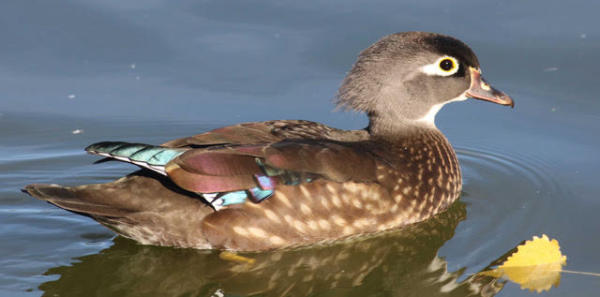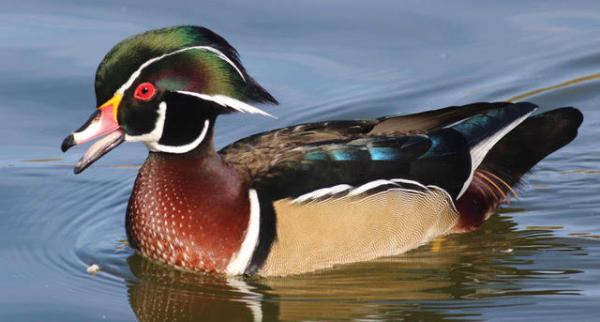

|
Wood Duck drakes are considered among the most beautiful birds in the world. Their colorful plumage is spectacular, not to mention iridescent, and it’s all set off by a spectacular oversized crest, and bright red eyes. The life history of Wood Ducks is equally impressive, if not surprising.
Like most waterfowl, female Wood Ducks have muted gray-brown plumage that allows them to hide better during the nesting period and while raising their brood of ducklings. However, after the nesting period, drakes molt into an “eclipse plumage” that makes them resemble a female in color. During this summer eclipse molt, these ducks become flightless while new wing feathers grow. This molt is typical among ducks and is thought to help males remain less conspicuous during their flightless period.
An impressive aspect of Wood Duck life history is the females’ choice of a nest site, usually a sizable tree cavity. At one time, such tree cavities were in short supply and became a limiting factor for many populations. However, birders and wildlife professionals came to the rescue by building and installing specialized Wood Duck nest boxes to give female Wood Ducks more nesting options. As a result, many populations have increased and some have actually expanded their range into areas beyond their characteristic woodland habitats.
As their name implies, Wood Ducks prefer shallow wetlands bordered with woods and, unlike most other ducks, they often perch in trees! A description of the life history of Wood Ducks follows:
Range: A true American duck, most Wood Ducks winter in our southeastern states and northern California. Their nesting range includes the eastern half of the United States and southeast portions of Canada; their western population ranges from central California north to southern British Columbia.
Habitats: Shallow marshes and river floodplains bordered by trees, especially oaks.
Mating: Wood Ducks form monogamous pair bonds tend to dissolve after egg laying begins.
Nest Sites: Inside a tree cavity or an elevated nest box.
Clutch Size: 8 to 14 white eggs.
Incubation Period: Females incubate 28 to 32 days. The female delays incubation until all eggs are laid, which ensures all eggs hatch in sync. The precocious ducklings leave the nest 24 to 48 hours after hatching, following the female to a nearby wetland.
Fledging: Ducklings fledge when 8 to 10 weeks old.
Food: Ducklings feed on aquatic invertebrates for the first 6 weeks and eat more aquatic plants and tubers thereafter. Acorns that have fallen into shallow water are favorite foods of adults and larger ducklings. Aquatic plant seeds are also eaten, and in some areas Woodies eat waste corn during fall and winter.
Conservation Status: Populations stable or increasing.